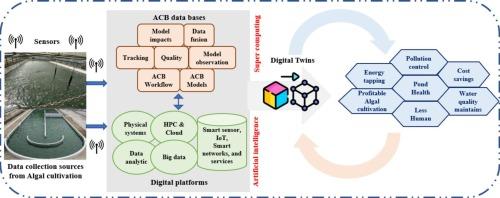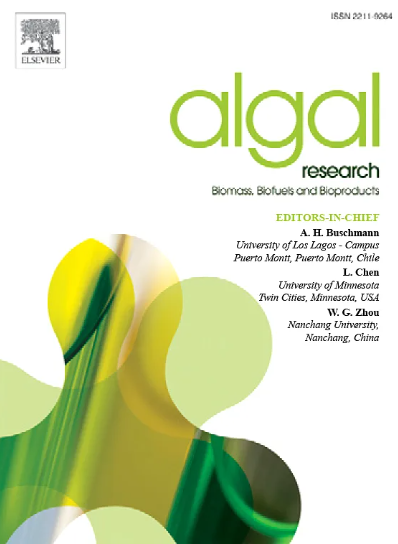利用数字孪生技术振兴藻类栽培,促进生物质生产--智能型可持续基础设施
IF 4.6
2区 生物学
Q1 BIOTECHNOLOGY & APPLIED MICROBIOLOGY
Algal Research-Biomass Biofuels and Bioproducts
Pub Date : 2024-10-28
DOI:10.1016/j.algal.2024.103779
引用次数: 0
摘要
工业 5.0 提高了人们对将传统工业技术转化为智能技术的认识,这些技术与可持续基础设施相结合,可有效处理流程系统,使其更具能源和成本效益。由于最近的科技发展,新的颠覆性技术不断涌现,对各种工艺系统产生了深远影响。用于生物质生产的藻类栽培技术(ACB)就是其中之一。一种被称为藻类数字孪生(ADT)的技术大有可为,它能将现有的藻类培养池(如赛道池塘)改造成可持续的藻类管理系统(氮、磷、温度、浊度、溶解氧(DO)、二氧化碳(CO2)、pH 值、叶绿素-a 等),并发展其基础设施,使其在藻类生物质培养方面更具能效和成本效益。然而,尽管近来关注度有所提高,但尚未有足够的研究来探讨在控制和监测 ACB 方面部署 ADTs 所面临的挑战。本综述提供了有关在 ACB 中采用 ADT 的系统文献分析,可解决 ACB 的主要困难和未决问题。此外,本研究还确定了几类主要障碍,如互联和语义、设施、获取数据和执行、数据可靠性、建模(人工智能物联网)、模拟运行、决策制定、数据数字化、问责制以及社会关切。此外,还报告了使用 ADT 对 ACB 进行脂质生产和废水处理的案例研究。总之,本综述旨在帮助从业人员深入了解如何将 ADT 部署到 ACB 系统中,"为 ACB 创建可持续智能基础设施的途径"。本文章由计算机程序翻译,如有差异,请以英文原文为准。

Reinvigorating algal cultivation for biomass production with digital twin technology - a smart sustainable infrastructure
Industry 5.0 raises awareness towards converting conventional industrial technologies into smart technologies integrated with sustainable infrastructure for efficiently handling process systems, making them more energy and cost-efficient. New disruptive technologies are emerging due to recent scientific and technical developments, which profoundly affect various process systems. One such case of consideration is the algal cultivation for biomass production (ACB). A technology called an algal digital twin (ADT) has a great deal of promise to change existing ACB (For example raceway pond) into sustainable algal management systems (Nitrogen, Phosphorus, Temperature, Turbidity, Dissolved Oxygen (DO), Carbon dioxide (CO2), pH, Chlorophyll-a, etc.), and to develop their infrastructure in making them more energy efficient and cost-effective for the algal biomass cultivation. However, despite a recent increase in attention, there have not been adequate investigations exploring the challenges of deploying ADTs for controlling and monitoring ACB. This review provides a systematic literature analysis on adopting an ADT into ACB, which could address major difficulties and unresolved problems of the ACB. Also, this study identifies several key categories of hurdles, such as interconnection and semantics, facilities, acquiring data and actuation, data reliability, modelling (Artificial Intelligence of Things), simulation run, decision making, digitalization of data, accountability, as well as social concerns. Additionally, case studies for the ACB towards lipid production and wastewater treatment using ADT are reported. Overall, this comprehensive review aims to help practitioners gain insight into the deployment of ADT into ACB systems, “A way towards creating a sustainable smart infrastructure for ACB”.
求助全文
通过发布文献求助,成功后即可免费获取论文全文。
去求助
来源期刊

Algal Research-Biomass Biofuels and Bioproducts
BIOTECHNOLOGY & APPLIED MICROBIOLOGY-
CiteScore
9.40
自引率
7.80%
发文量
332
期刊介绍:
Algal Research is an international phycology journal covering all areas of emerging technologies in algae biology, biomass production, cultivation, harvesting, extraction, bioproducts, biorefinery, engineering, and econometrics. Algae is defined to include cyanobacteria, microalgae, and protists and symbionts of interest in biotechnology. The journal publishes original research and reviews for the following scope: algal biology, including but not exclusive to: phylogeny, biodiversity, molecular traits, metabolic regulation, and genetic engineering, algal cultivation, e.g. phototrophic systems, heterotrophic systems, and mixotrophic systems, algal harvesting and extraction systems, biotechnology to convert algal biomass and components into biofuels and bioproducts, e.g., nutraceuticals, pharmaceuticals, animal feed, plastics, etc. algal products and their economic assessment
 求助内容:
求助内容: 应助结果提醒方式:
应助结果提醒方式:


